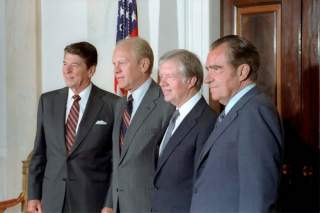Perlstein's Bridge to Nowhere
A simplistic attempt to explain the rise of the modern American right.
His listeners remembered those shameful images of the evacuation of Saigon, that line of bodies snaking up the ladder to that shack atop the CIA station chief’s home. God’s chosen nation, with its tail between its legs. They remembered those Panamanian riots from 1964, and now Panama was being rewarded for rioting—just like those ungrateful Negroes in those Northern cities they had left behind to retire in Florida; they had rioted, and then got more civil rights bills and social programs. . . . And now Jerry Ford was ready to let it happen again.
Dwight Macdonald famously excoriated New Journalism as “parajournalism,” which he defined as “a bastard form, having it both ways, exploiting the factual authority of journalism and the atmospheric license of fiction.” In passages like the one above, Perlstein doesn’t just come close to parahistory—he embraces it.
There’s also a basic inconsistency in Perlstein casting nostalgia as a vice, given that his main strength as an author is precisely his ability to spin nostalgic, detailed, you-are-there narratives of events such as the 1976 Republican National Convention. Readers who make it through all eight hundred pages of The Invisible Bridge most likely will enjoy immersing themselves in the 1970s and, even more, being able to put the book down and leave that troubled decade.
But Perlstein ultimately is purveying a shallow and tendentious version of history that will only convince the already converted: those who believe in the innate baseness of conservatives. He is not writing what his publisher boasts “is becoming the classic series of books about the rise of modern conservatism in America” in order to investigate and understand but rather to mock and condemn. This is history that sets out to expose the limitations of conservatives but ends up exposing the limitations of the author. Anyone seeking a definitive history of the transition from Nixon to Reagan should look elsewhere.
Geoffrey Kabaservice is the author, most recently, of Rule and Ruin: The Downfall of Moderation and the Destruction of the Republican Party, from Eisenhower to the Tea Party (Oxford University Press, 2012).
1 William A. Rusher to James Gavin, June 3, 1975. William F. Buckley Jr. Papers (Yale University) 34:5.
2 William A. Rusher to Jameson G. Campaigne Jr., May 10, 1976. William A. Rusher Papers (Library of Congress) 18:6.
3 John Ashbrook to Michael Djordjevich, March 21, 1975. Rusher Papers 26:3.

